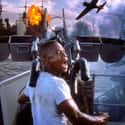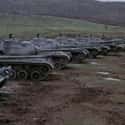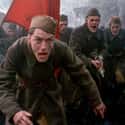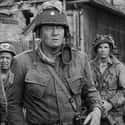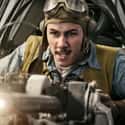-
(#1) The Soldiers Were Men In Their 30s And 40s
The Trope: The typical WWII combatant was a tough and grizzled 30- or 40-something, best portrayed by Hollywood’s leading middle-aged actors like the Toms Hanks and Hardy.
Why Is It Inaccurate?: The average WWII soldier was much younger than the average age of the actors who portray them on film. Or, as the Saturday Evening Post puts it:
[I]f you were the average frontline G.I., you would fit the following description.
You are a 26-years-old white male with nine years of education, who comes from New York and is named John. You were drafted into the army and are now a rifleman in the infantry with a rank of private.
Back home, you have a wife and at least one child hoping for your return.
You are five feet, eight inches tall, and you weigh 144 pounds. During your basic training, which you received at Fort Benning, GA, you gained 5 to 20 pounds and added an inch to your 33 ¼” chest.That may not sound like the stuff of a blockbuster action flick, but it is reality. And while older actors may add gravitas to a role, so too does the knowledge that the majority of those who fought and perished in the war still had their whole lives ahead of them.
Even combat officers tended to be young; for instance, Easy Company's commander, Major Dick Winters, was all of 27 when the war ended. By contrast, Hanks was 41 when he portrayed the fictional Captain John Miller in Private Ryan (although, according to this fan wiki, the character is supposed to be "only" 34). Meanwhile, Tom Sizemore, who played Sgt. Horvath, was 35 when Ryan was filmed.
Notable Offenders: Saving Private Ryan, The Longest Day, Battle of the Bulge
-
(#2) PG-13 Films Can Accurately Portray The Carnage
The Trope: In any PG-13 WWII flick, there may be a little death and destruction, but only of the family-friendly variety. A soldier may perish, but usually only from a single gunshot wound that produces little blood and allows him enough time to squeeze in a quick soliloquy.
Why Is It Inaccurate?: War is hell, the kind of hell that can only be replicated by the hardest of R-ratings. Though gunfire undoubtedly produced far more gruesome injuries than those seen on the big screen, the grisliest scenes were often the result of artillery and mortar fire, which could reduce an entire human being to a fine red mist.
If a film were to accurately portray the true, ceaseless carnage of WWII, it would turn the stomach of most audience members, as it did for many of those who had to witness it firsthand. Take Quentin Aanenson’s recollections, for instance:
It was on one of my early missions that I knew I had, I’d killed men..We caught a group of Germans that were on a road in an area where there were no trees. And I remember the impact it had on me when I could see my bullets just tearing into them. That was my job. This is what I’d been trained to do, and I dealt with it fine. But when I got back home to the base in Normandy and landed I got sick. I had to think about what I had done. Now that didn’t change my resolve. I went out and did it again. And again and again and again.
Notable Offenders: Pearl Harbor is probably the worst offender, but it’s actually easier to list those few films that come close to capturing the carnage, like Hacksaw Ridge and Saving Private Ryan.
-
(#3) Women Spent The War Sitting At Home, Pining Over Their Sweethearts
The Trope: If you’re seeing a woman in a prominent role in a WWII movie, it's almost certainly as a love interest back on the homefront, pining for a sweetheart off playing a prominent role in the actual war.
Why Is It Inaccurate?: Women didn’t just contribute to the war efforts of every nation involved in WWII, they were unquestionably integral to them. When it came to America and Britain, women aided Allied victory through both indirect - think Rosie the Riveter - and direct means, including serving in the military itself as nurses and in other various roles, and dying for their country right alongside the men. Sixteen American women were slain as a direct result of enemy gunfire while with the Army Nurse Corps, and many others were slain in bombing raids while serving near the front lines.
Women from other Allied nations were even more engaged, with some 800,000 Soviet women serving in army units throughout the war, including famed sniper Lyudmila Pavlichenko, who took out 309 German soldiers.
Notable Offenders: Battle of the Bulge, The Pacific, Band of Brothers
-
(#4) Two Clear Sides Square Off Perfectly, With Little Confusion Over Who's Who
The Trope: WWII battles appear to have been fought in much the same fashion as every other historical era of combat as portrayed on film, with two clearly distinct sides facing off against one another on a nice, neatly defined battleground.
Why Is It Inaccurate?: Even with its predominance of trench warfare, even WWI didn’t truly match the above description most of the time, and the sequel was an entirely different experience altogether. WWII saw soldiers fighting in all manner of terrain and without always having the benefits of nice and neat battlelines. As such, chaos often reigned, as supply officer John Higgins recalled:
The confusion in the jungle you have to experience. It's hard to believe that two infantry battalions could blunder into each other unless you were there in the jungle where you couldn't see, you know, 10 feet in front of you.
Further evidence of that notion is given by the sheer number of fatal friendly fire incidents that took place in WWII, including mistakes that left hundreds of Allies dead at a time. As if that weren’t confusing and chaotic enough, Germans were even known to occasionally sneak behind Allied lines in stolen uniforms to wreak havoc, further blurring the fog of combat.
Notable Offenders: Battle of the Bulge, Enemy at the Gates, Windtalkers
-
(#5) Battles Involving Millions Of Soldiers Completely Depend On The Fortune Of One Or Two Characters
The Trope: Though an entire world war may rage on around them, the actions of one protagonist soldier, and perhaps a couple of key supporting characters, are all that stands between their nation and total defeat.
Why Is It Inaccurate?: Millions upon millions of men and women fought in WWII, and though many distinguished themselves with their singular bravery, battles never depended on the doings of a single person. The most egregious abuser of this trope is Enemy at the Gates, a film based on the breathless memoir of Soviet sniper Vasily Zaitsev, played by Jude Law. It reads:
Kulikov fires off a blind shot. We have to arouse the sniper's interest. We decide to sit out the first half of the day; light reflecting from the scopes could give us away. In the afternoon our rifles are in the shade while the direct light of the sun falls upon the German's position.
Something sparkles by the edge of the sheet. Is this a piece of glass that just happens to be there, or is the telescopic sight of a sniper's rifle?As the movie and Zaitsev himself seem to imply, nearly the entirety of the siege of Stalingrad hinged on a one-on-one sniper duel between him and his counterpart, Major Konig, whom the German high command had dispatched for the express purpose of neutralizing Zaitsev. In reality, the duel almost certainly never happened, Konig probably didn’t even exist, and the events at Stalingrad were far broader and more complex than Hollywood and its love of exceptional men would have you believe.
Notable Offenders: Enemy at the Gates, The Great Escape, Fury
-
(#6) Ammunition Never Runs Out
The Trope: Film characters can go an entire two-and-a-half hour movie without ever needing to reload their weapons, despite firing large and indiscriminate bursts of ammunition with alarming frequency.
Why Is It Inaccurate?: Supply chains are an ever-underrated and pivotal aspect of warfare, and the limitations thereof have always ensured that real-life soldiers are a lot more conservative with their ammo than their Hollywood counterparts. This is especially true when it comes to WWII, with infantry usually able to carry a hundred or so rounds at most into battle, and often far fewer.
It’s also especially true when it came to WWII-era aircraft. The notion of one pilot shooting down multiple enemy bogies on a single run is essentially fiction, with Spitfires specifically carrying 14 seconds' worth of ammo on them at a time. Apparently, nobody told Tom Hardy.
Notable Offenders: Dunkirk, Saving Private Ryan, Where Eagles Dare. In fact, it’d be far easier to list those few programs that make of point of showing their characters reloading and conserving ammo, like Band of Brothers.
-
(#7) Bullets Will Rip Through You Underwater
The Trope: A soldier attempting to storm a beach, probably somewhere near Normandy, has second thoughts when they’re met with a barrage of bullets and dives back under the surf they emerged from for protection - only to have the bullets rip through the water and puncture their body anyway.
Why Is It Inaccurate?: Consider that, as recently as 2019, US Special Forces were still hard at working trying to invent a bullet that would travel effectively underwater. Water is, after all, 800 times denser than air, which is what most bullets are designed to pass through. In reality, and as The Smithsonian Channel and the Mythbusters have both conclusively proven, bullets can only pass through a few feet of water at the absolute most, continuously slowing down as they go. As it turns out, real soldiers on D-Day could, and did, earn a temporary reprieve from oncoming gunfire by ducking under the waves.
Notable Offenders: No film is more guilty of this than Saving Private Ryan, where director Steven Spielberg described the difficulty he had replicating bullets passing through water on film without realizing the obvious reason why that was: “Often the pellets wouldn’t go far enough but at least they gave us a really good reference so we were able to digitally augment the shot with a stronger visual of a projectile coursing through the water.”
-
(#8) D-Day Was A Lightning-Quick, Over-And-Done Affair
The Trope: The invasion of German-occupied Europe that took place on D-Day only took a single day, and appears to have been doable in the span of a single motion picture. After all, it’s D-Day, not D-Week, right?
Why Is It Inaccurate?: The Battle of Normandy was an enormous undertaking, and it took an appropriately enormous amount of time. With the invasion beginning at 6:30 am on June 6, 1944, the Allies had landed more than 156,000 troops and established several beachheads by the day’s end - but the work was far from complete. The beaches of Normandy would not be fully secure until June 11, five days later. Films like to portray D-Day as an uphill battle of an hour or two at most, after which the Americans punched through the enemy fortifications and were ready to roll across France, but the truth is much lengthier.
Notable Offenders: Saving Private Ryan, Patton, and, somewhat ironically, The Longest Day
-
(#9) Battles Are Usually Fought On Smooth Terrain In Perfect Weather
The Trope: It does seem mighty convenient that so many WWII battles happened to take place during the sort of weather, and on the sort of terrain, that are particularly conducive to easy filming.
Why Is It Inaccurate?: Of course, the real WWII was fought in every type of weather imaginable, and on terrain as diverse as, well, the bulk of Europe and the Pacific Theatre. In fact, weather good and bad played such an important role in the war the Germans initially suffered from their lack of prognostication ability, until they made a point of invading two prime weather-watching nations in Denmark and Norway in 1940.
Some battles that have been rendered on the silver screen as having pristine conditions, like the Battle of the Bulge or D-Day, actually featured rough terrain and rougher weather as a defining factor. As Normandy vet Ray Pegram remembers:
I remember with first glider tow, we hit a fog bank and we were very nervous, but the formation separated by pattern, according to plan…Clouds prevented them from dropping to the ground close together, like they wanted to. Because of the cloud cover, we had to break formation, so the first drops were very scattered. They had a hard time assembling on the ground because they were so scattered. But the next drops, we could do a better job putting them down together.
Notable Offenders: Battle of the Bulge, The Great Escape, The Longest Day
-
(#10) The Uniforms Just Have To Look Cool
The Trope: That the uniforms don’t all look exactly the same in every WWII movie should tell you something - clearly, somebody’s got it wrong.
Why Is It Inaccurate?: The apparent ineptitude of Hollywood when it comes to crafting accurate military costumes is so prevalent that it has sparked rumors of an obscure law preventing exact replications, but in fact the Supreme Court has ruled the very opposite. It seems instead that the reason behind the inconsistency is just a clash between actual military advisers and costume designers with a flair for originality. As retired Marine Captain Dale Dye, who advised on Saving Private Ryan, describes:
They figure that the wardrobe people will do their research. The problem is wardrobe people who've never worn a uniform can do their research but they don't know what they're talking about. They don't know how to wear it. They don't have the insight… I've said to costume designers, 'Where the hell did you come up with this? What is this?' 'Oh, it just looked cool.' And it immediately comes off.
Notable Offenders: Pearl Harbor, Fury, Midway, and any other film where coolness is substituted for accuracy.
-
(#11) People Carried On Casual Conversations Over All The Noise
The Trope: Amid the chaos of battle, two or more troopmates engage in pages full of dialogue, most of which centers around what they’d each like the other to tell their wives if they don’t make it.
Why Is It Inaccurate?: Real WWII battles were really, really loud. So loud that they caused mass hearing loss in veterans, and definitely loud enough that carrying out conversations in battle would be near impossible, save for those precious moments free of any gunfire, artillery, or explosions. Reporter George Hicks brought a recorder with him to the coast of Normandy on D-Day, and his tapes attest to the noisy chaos of combat - where every bit of communication is shouted at the top of one’s lungs, and barely heard anyway. The constant presence of mortar fire and airplanes overheard was described by those on the ground as "deafening and unignorable," which doesn’t leave much room for heart-to-hearts.
Notable Offenders: Since no one wants to go into a theater and sustain hearing loss, it’s a given that every Hollywood take on WWII will be guilty of this trope to one extent or another.
-
(#12) The Axis Side Suffered Way More Casualties Than The Allies
The Trope: Though you’re obviously supposed to care more about deaths on the Allied side in Hollywood WWII movies, they’re far less frequent than the demises of those aligned with the Axis, who regularly get mowed down in waves yet never seem to stop coming. Which seems to make sense, given that they did lose and all.
Why Is It Inaccurate?: Far more military casualties occurred on the Allied side than on the Axis. The Soviet Union alone, with its estimated 7.5 million dead, lost more soldiers than Germany, Japan, and Italy combined. China suffered almost double the losses Japan did. This is another trope that clearly views the conflict through an American lens, as the US "only" suffered 405,399 dead and another 670,846 wounded.
Notable Offenders: Midway, Inglorious Basterds
-
(#13) Everything Important In The War Was Done By Americans
The Trope: If there’s one thing that Hollywood serves to reinforce, it’s that America won WWII more-or-less singlehandedly, with only the occasional assist from someone with a British accent for the sake of variety.
Why Is It Inaccurate?: Not only did America not even join the war effort until December of 1941, when it had been raging for over two years, they were far from the solitary supplier of soldiers to the Allied cause - nor were they the largest. That honor goes to the Soviet Union, who had an estimated 12.5 million people in service at their peak, just edging out the US’s 12,364,000 (and total Soviet casualties were far, far higher than America's). Millions more fought alongside the Allies from nations like India, Canada, Australia, and the Philippines.
Occasionally, American-made films will even go as far as to insert Americans into WWII stories that have nothing to do with them. Such is the case of U-571, which insinuates it was the US - and not, as it actually was, Britain - that captured the Enigma code machine from a German U-boat. At the time of its release, British Prime Minister Tony Blair called the film an “affront.”
Another prominent example The Great Escape, took the 76 real Allied soldiers - from nations as diverse as Norway and the Netherlands - and replaced them with Americans like Steve McQueen. In reality, all of the real-life Americans involved in the breakout from Stalag Luft III had been transferred to another facility before the plan was hatched.
Notable Offenders: U-571, The Great Escape, The Pacific
New Random Displays Display All By Ranking
About This Tool
Our data comes from Ranker, If you want to participate in the ranking of items displayed on this page, please click here.







